INTL 702 Banking Project: CBA Business Expansion in Australia
VerifiedAdded on 2023/01/19
|15
|3708
|33
Project
AI Summary
This project analyzes the Commonwealth Bank (CBA) in Australia for a Canadian client's business expansion, considering the country's financial market and relevant policies. It evaluates Australian regulations designed to mitigate financial crises and protect clients, assessing political, economic, legal, and cultural risks. The project recommends CBA, highlighting its strengths, services, and international presence, including its relationship with the Royal Bank of Canada. It suggests a Market Rate Loan and addresses foreign exchange rate risks, advising on hedging strategies through exchange-traded funds and forward contracts. The report discusses profit and capital repatriation, offering a comprehensive overview of the expansion strategy, loan details and risk management for the client.

Running head: BANKING
Banking
Name of the Student
Name of the University
Author’s Note
Banking
Name of the Student
Name of the University
Author’s Note
Paraphrase This Document
Need a fresh take? Get an instant paraphrase of this document with our AI Paraphraser
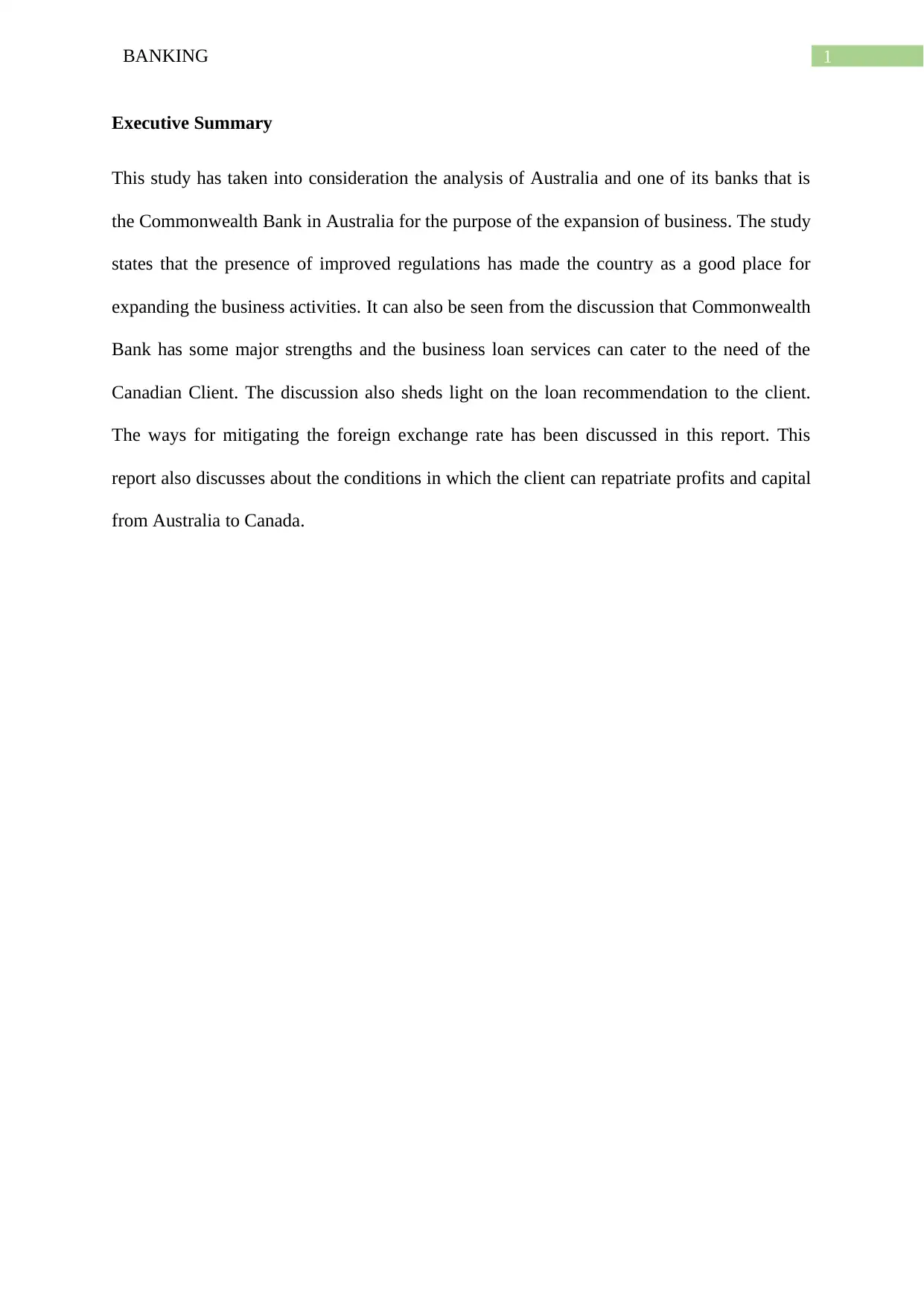
1BANKING
Executive Summary
This study has taken into consideration the analysis of Australia and one of its banks that is
the Commonwealth Bank in Australia for the purpose of the expansion of business. The study
states that the presence of improved regulations has made the country as a good place for
expanding the business activities. It can also be seen from the discussion that Commonwealth
Bank has some major strengths and the business loan services can cater to the need of the
Canadian Client. The discussion also sheds light on the loan recommendation to the client.
The ways for mitigating the foreign exchange rate has been discussed in this report. This
report also discusses about the conditions in which the client can repatriate profits and capital
from Australia to Canada.
Executive Summary
This study has taken into consideration the analysis of Australia and one of its banks that is
the Commonwealth Bank in Australia for the purpose of the expansion of business. The study
states that the presence of improved regulations has made the country as a good place for
expanding the business activities. It can also be seen from the discussion that Commonwealth
Bank has some major strengths and the business loan services can cater to the need of the
Canadian Client. The discussion also sheds light on the loan recommendation to the client.
The ways for mitigating the foreign exchange rate has been discussed in this report. This
report also discusses about the conditions in which the client can repatriate profits and capital
from Australia to Canada.
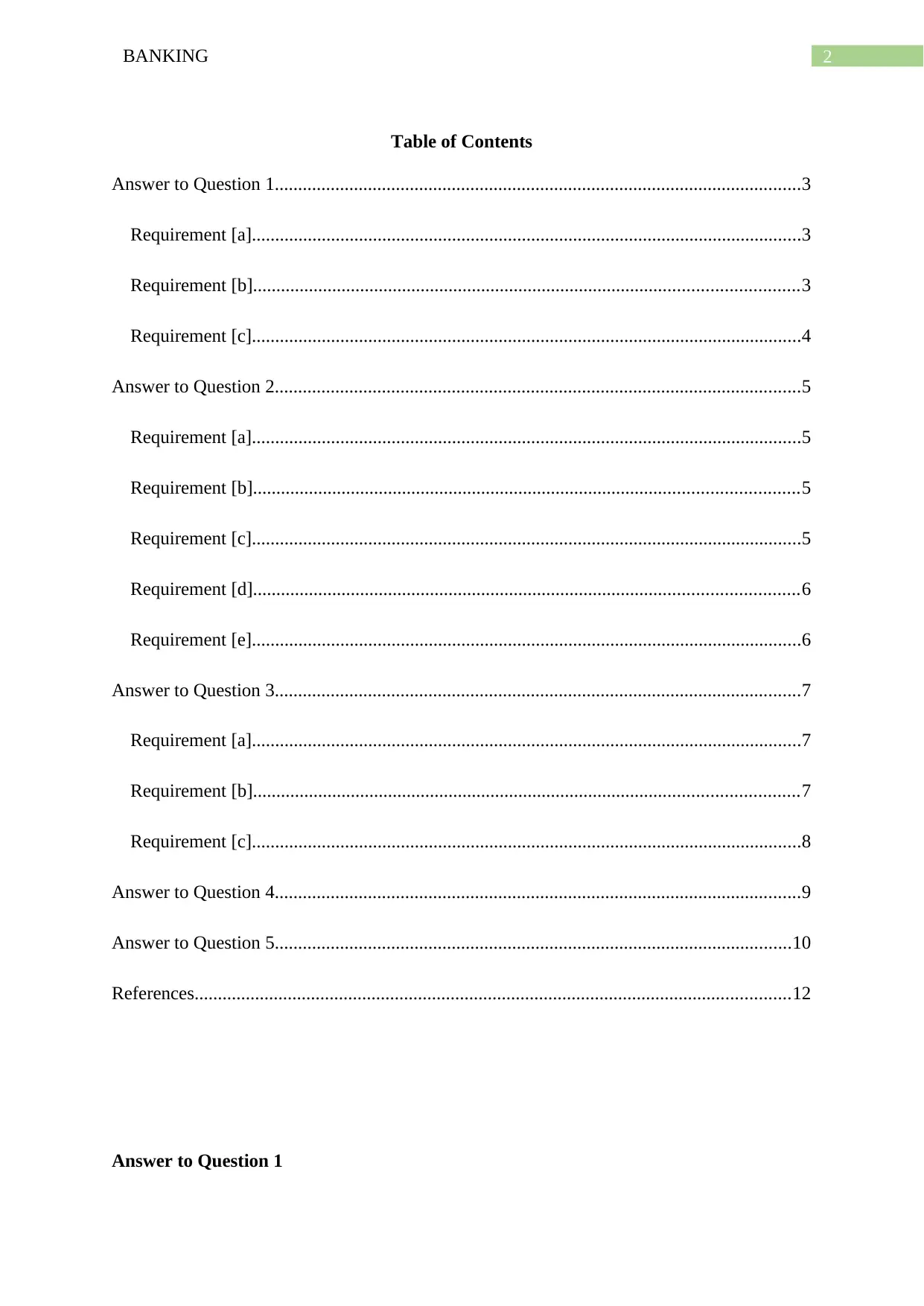
2BANKING
Table of Contents
Answer to Question 1.................................................................................................................3
Requirement [a]......................................................................................................................3
Requirement [b].....................................................................................................................3
Requirement [c]......................................................................................................................4
Answer to Question 2.................................................................................................................5
Requirement [a]......................................................................................................................5
Requirement [b].....................................................................................................................5
Requirement [c]......................................................................................................................5
Requirement [d].....................................................................................................................6
Requirement [e]......................................................................................................................6
Answer to Question 3.................................................................................................................7
Requirement [a]......................................................................................................................7
Requirement [b].....................................................................................................................7
Requirement [c]......................................................................................................................8
Answer to Question 4.................................................................................................................9
Answer to Question 5...............................................................................................................10
References................................................................................................................................12
Answer to Question 1
Table of Contents
Answer to Question 1.................................................................................................................3
Requirement [a]......................................................................................................................3
Requirement [b].....................................................................................................................3
Requirement [c]......................................................................................................................4
Answer to Question 2.................................................................................................................5
Requirement [a]......................................................................................................................5
Requirement [b].....................................................................................................................5
Requirement [c]......................................................................................................................5
Requirement [d].....................................................................................................................6
Requirement [e]......................................................................................................................6
Answer to Question 3.................................................................................................................7
Requirement [a]......................................................................................................................7
Requirement [b].....................................................................................................................7
Requirement [c]......................................................................................................................8
Answer to Question 4.................................................................................................................9
Answer to Question 5...............................................................................................................10
References................................................................................................................................12
Answer to Question 1
⊘ This is a preview!⊘
Do you want full access?
Subscribe today to unlock all pages.

Trusted by 1+ million students worldwide
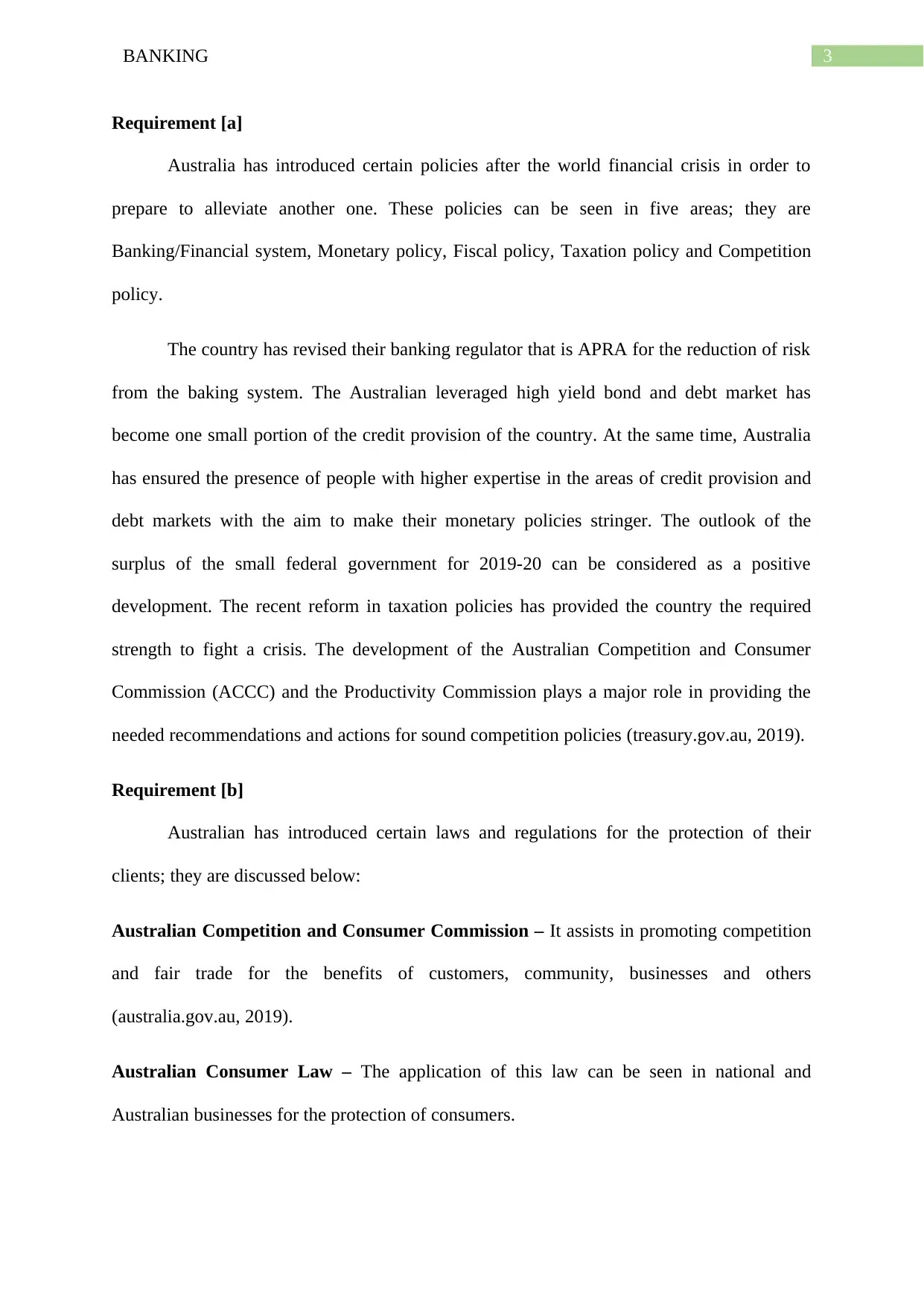
3BANKING
Requirement [a]
Australia has introduced certain policies after the world financial crisis in order to
prepare to alleviate another one. These policies can be seen in five areas; they are
Banking/Financial system, Monetary policy, Fiscal policy, Taxation policy and Competition
policy.
The country has revised their banking regulator that is APRA for the reduction of risk
from the baking system. The Australian leveraged high yield bond and debt market has
become one small portion of the credit provision of the country. At the same time, Australia
has ensured the presence of people with higher expertise in the areas of credit provision and
debt markets with the aim to make their monetary policies stringer. The outlook of the
surplus of the small federal government for 2019-20 can be considered as a positive
development. The recent reform in taxation policies has provided the country the required
strength to fight a crisis. The development of the Australian Competition and Consumer
Commission (ACCC) and the Productivity Commission plays a major role in providing the
needed recommendations and actions for sound competition policies (treasury.gov.au, 2019).
Requirement [b]
Australian has introduced certain laws and regulations for the protection of their
clients; they are discussed below:
Australian Competition and Consumer Commission – It assists in promoting competition
and fair trade for the benefits of customers, community, businesses and others
(australia.gov.au, 2019).
Australian Consumer Law – The application of this law can be seen in national and
Australian businesses for the protection of consumers.
Requirement [a]
Australia has introduced certain policies after the world financial crisis in order to
prepare to alleviate another one. These policies can be seen in five areas; they are
Banking/Financial system, Monetary policy, Fiscal policy, Taxation policy and Competition
policy.
The country has revised their banking regulator that is APRA for the reduction of risk
from the baking system. The Australian leveraged high yield bond and debt market has
become one small portion of the credit provision of the country. At the same time, Australia
has ensured the presence of people with higher expertise in the areas of credit provision and
debt markets with the aim to make their monetary policies stringer. The outlook of the
surplus of the small federal government for 2019-20 can be considered as a positive
development. The recent reform in taxation policies has provided the country the required
strength to fight a crisis. The development of the Australian Competition and Consumer
Commission (ACCC) and the Productivity Commission plays a major role in providing the
needed recommendations and actions for sound competition policies (treasury.gov.au, 2019).
Requirement [b]
Australian has introduced certain laws and regulations for the protection of their
clients; they are discussed below:
Australian Competition and Consumer Commission – It assists in promoting competition
and fair trade for the benefits of customers, community, businesses and others
(australia.gov.au, 2019).
Australian Consumer Law – The application of this law can be seen in national and
Australian businesses for the protection of consumers.
Paraphrase This Document
Need a fresh take? Get an instant paraphrase of this document with our AI Paraphraser
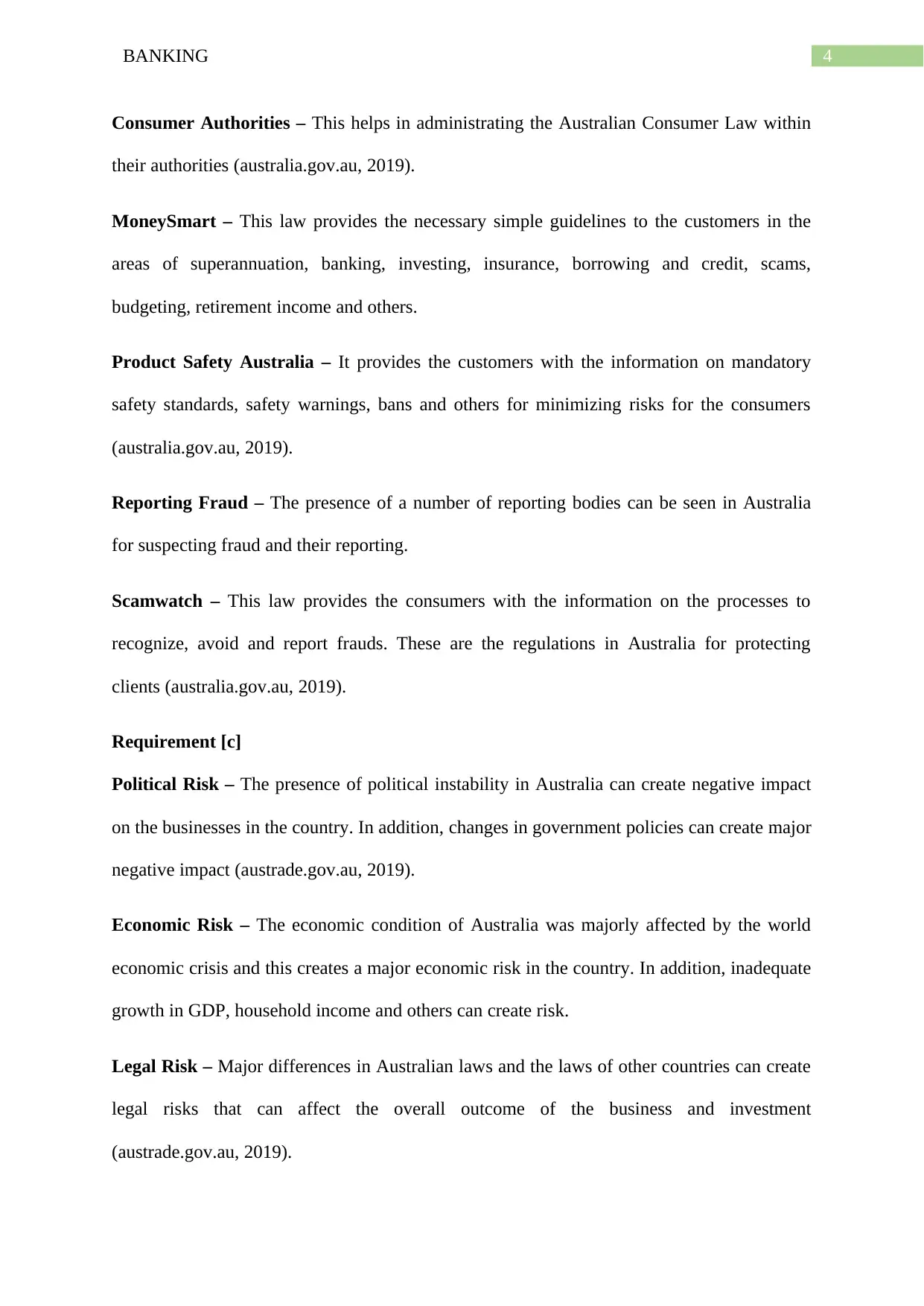
4BANKING
Consumer Authorities – This helps in administrating the Australian Consumer Law within
their authorities (australia.gov.au, 2019).
MoneySmart – This law provides the necessary simple guidelines to the customers in the
areas of superannuation, banking, investing, insurance, borrowing and credit, scams,
budgeting, retirement income and others.
Product Safety Australia – It provides the customers with the information on mandatory
safety standards, safety warnings, bans and others for minimizing risks for the consumers
(australia.gov.au, 2019).
Reporting Fraud – The presence of a number of reporting bodies can be seen in Australia
for suspecting fraud and their reporting.
Scamwatch – This law provides the consumers with the information on the processes to
recognize, avoid and report frauds. These are the regulations in Australia for protecting
clients (australia.gov.au, 2019).
Requirement [c]
Political Risk – The presence of political instability in Australia can create negative impact
on the businesses in the country. In addition, changes in government policies can create major
negative impact (austrade.gov.au, 2019).
Economic Risk – The economic condition of Australia was majorly affected by the world
economic crisis and this creates a major economic risk in the country. In addition, inadequate
growth in GDP, household income and others can create risk.
Legal Risk – Major differences in Australian laws and the laws of other countries can create
legal risks that can affect the overall outcome of the business and investment
(austrade.gov.au, 2019).
Consumer Authorities – This helps in administrating the Australian Consumer Law within
their authorities (australia.gov.au, 2019).
MoneySmart – This law provides the necessary simple guidelines to the customers in the
areas of superannuation, banking, investing, insurance, borrowing and credit, scams,
budgeting, retirement income and others.
Product Safety Australia – It provides the customers with the information on mandatory
safety standards, safety warnings, bans and others for minimizing risks for the consumers
(australia.gov.au, 2019).
Reporting Fraud – The presence of a number of reporting bodies can be seen in Australia
for suspecting fraud and their reporting.
Scamwatch – This law provides the consumers with the information on the processes to
recognize, avoid and report frauds. These are the regulations in Australia for protecting
clients (australia.gov.au, 2019).
Requirement [c]
Political Risk – The presence of political instability in Australia can create negative impact
on the businesses in the country. In addition, changes in government policies can create major
negative impact (austrade.gov.au, 2019).
Economic Risk – The economic condition of Australia was majorly affected by the world
economic crisis and this creates a major economic risk in the country. In addition, inadequate
growth in GDP, household income and others can create risk.
Legal Risk – Major differences in Australian laws and the laws of other countries can create
legal risks that can affect the overall outcome of the business and investment
(austrade.gov.au, 2019).
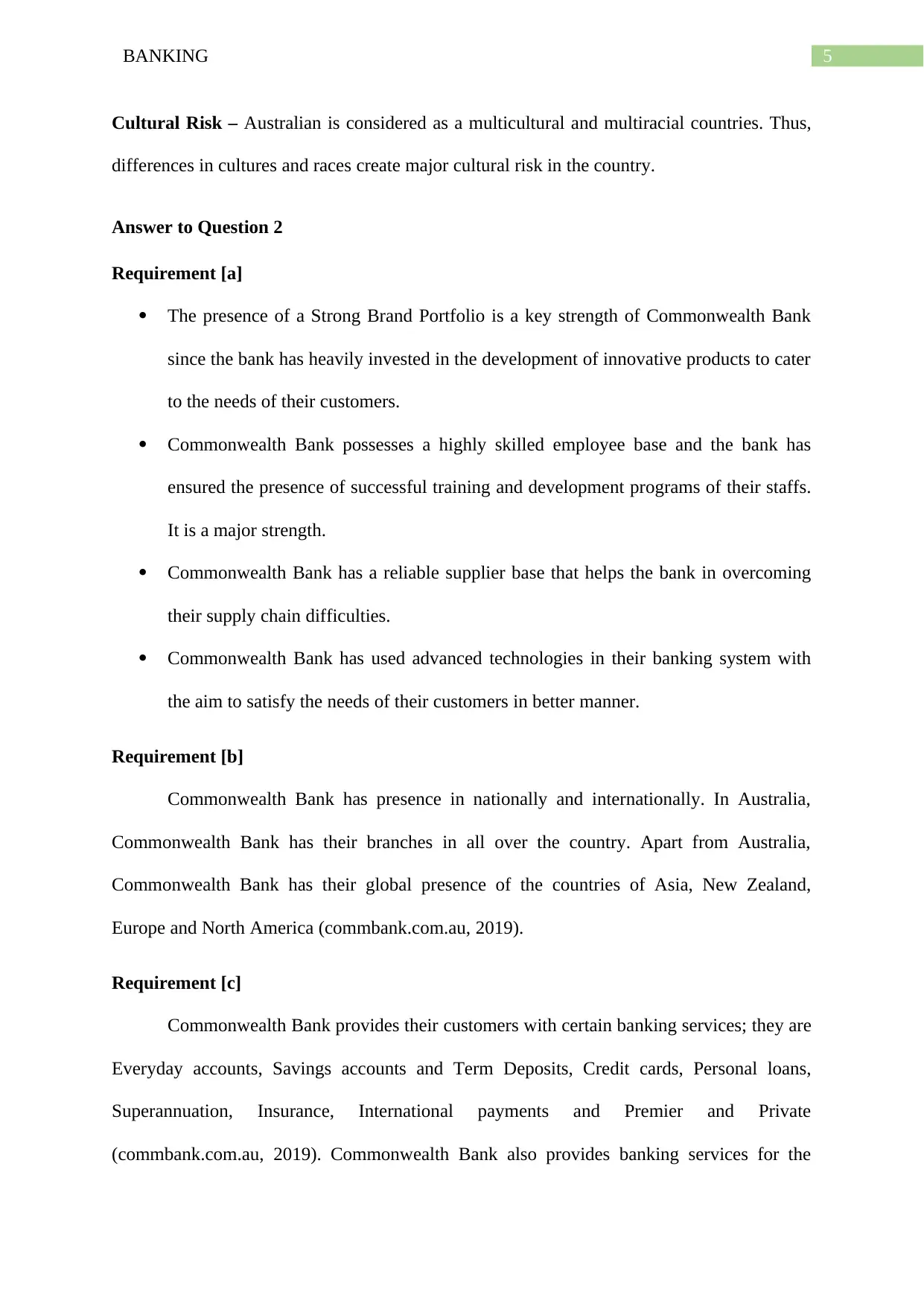
5BANKING
Cultural Risk – Australian is considered as a multicultural and multiracial countries. Thus,
differences in cultures and races create major cultural risk in the country.
Answer to Question 2
Requirement [a]
The presence of a Strong Brand Portfolio is a key strength of Commonwealth Bank
since the bank has heavily invested in the development of innovative products to cater
to the needs of their customers.
Commonwealth Bank possesses a highly skilled employee base and the bank has
ensured the presence of successful training and development programs of their staffs.
It is a major strength.
Commonwealth Bank has a reliable supplier base that helps the bank in overcoming
their supply chain difficulties.
Commonwealth Bank has used advanced technologies in their banking system with
the aim to satisfy the needs of their customers in better manner.
Requirement [b]
Commonwealth Bank has presence in nationally and internationally. In Australia,
Commonwealth Bank has their branches in all over the country. Apart from Australia,
Commonwealth Bank has their global presence of the countries of Asia, New Zealand,
Europe and North America (commbank.com.au, 2019).
Requirement [c]
Commonwealth Bank provides their customers with certain banking services; they are
Everyday accounts, Savings accounts and Term Deposits, Credit cards, Personal loans,
Superannuation, Insurance, International payments and Premier and Private
(commbank.com.au, 2019). Commonwealth Bank also provides banking services for the
Cultural Risk – Australian is considered as a multicultural and multiracial countries. Thus,
differences in cultures and races create major cultural risk in the country.
Answer to Question 2
Requirement [a]
The presence of a Strong Brand Portfolio is a key strength of Commonwealth Bank
since the bank has heavily invested in the development of innovative products to cater
to the needs of their customers.
Commonwealth Bank possesses a highly skilled employee base and the bank has
ensured the presence of successful training and development programs of their staffs.
It is a major strength.
Commonwealth Bank has a reliable supplier base that helps the bank in overcoming
their supply chain difficulties.
Commonwealth Bank has used advanced technologies in their banking system with
the aim to satisfy the needs of their customers in better manner.
Requirement [b]
Commonwealth Bank has presence in nationally and internationally. In Australia,
Commonwealth Bank has their branches in all over the country. Apart from Australia,
Commonwealth Bank has their global presence of the countries of Asia, New Zealand,
Europe and North America (commbank.com.au, 2019).
Requirement [c]
Commonwealth Bank provides their customers with certain banking services; they are
Everyday accounts, Savings accounts and Term Deposits, Credit cards, Personal loans,
Superannuation, Insurance, International payments and Premier and Private
(commbank.com.au, 2019). Commonwealth Bank also provides banking services for the
⊘ This is a preview!⊘
Do you want full access?
Subscribe today to unlock all pages.

Trusted by 1+ million students worldwide
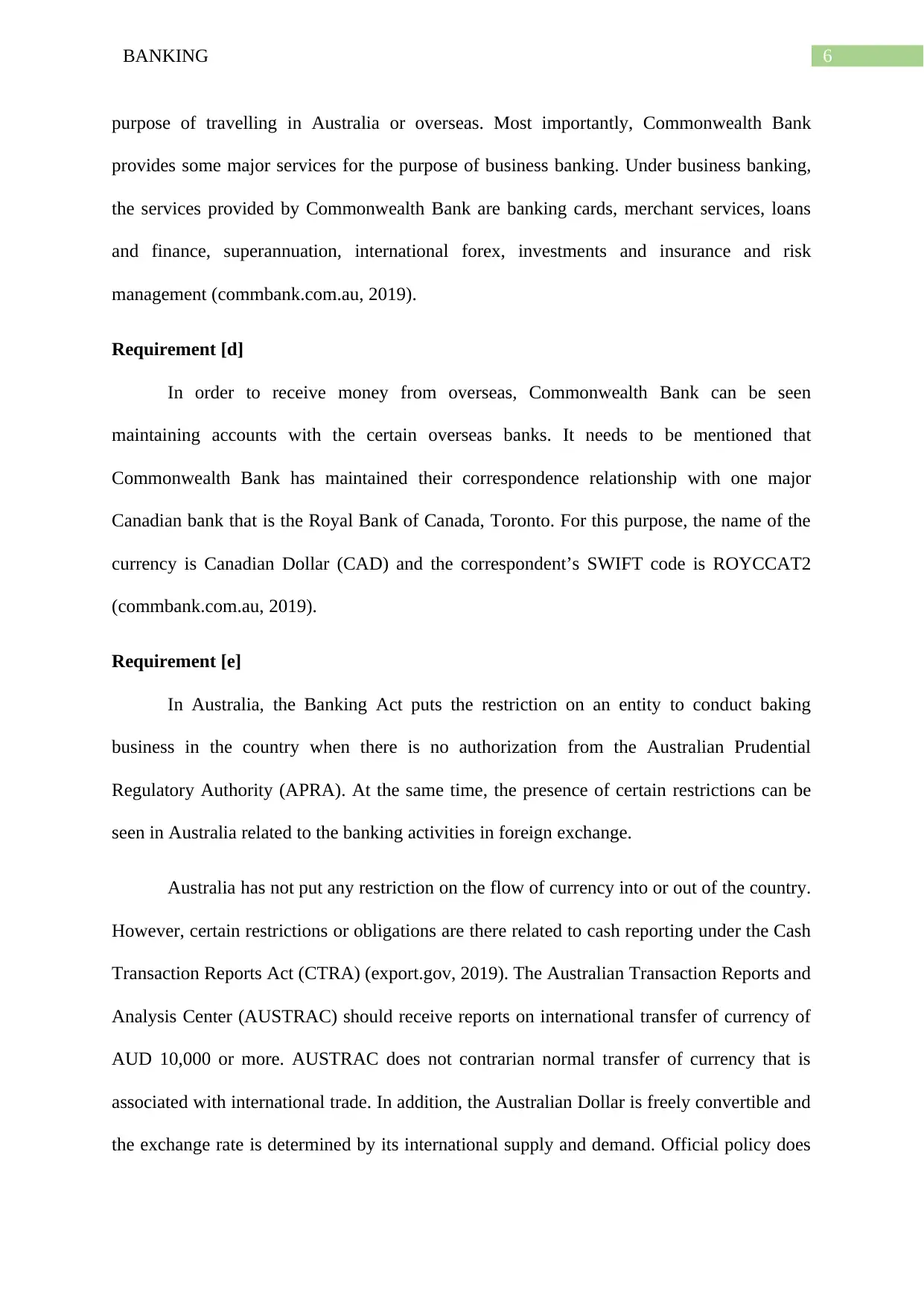
6BANKING
purpose of travelling in Australia or overseas. Most importantly, Commonwealth Bank
provides some major services for the purpose of business banking. Under business banking,
the services provided by Commonwealth Bank are banking cards, merchant services, loans
and finance, superannuation, international forex, investments and insurance and risk
management (commbank.com.au, 2019).
Requirement [d]
In order to receive money from overseas, Commonwealth Bank can be seen
maintaining accounts with the certain overseas banks. It needs to be mentioned that
Commonwealth Bank has maintained their correspondence relationship with one major
Canadian bank that is the Royal Bank of Canada, Toronto. For this purpose, the name of the
currency is Canadian Dollar (CAD) and the correspondent’s SWIFT code is ROYCCAT2
(commbank.com.au, 2019).
Requirement [e]
In Australia, the Banking Act puts the restriction on an entity to conduct baking
business in the country when there is no authorization from the Australian Prudential
Regulatory Authority (APRA). At the same time, the presence of certain restrictions can be
seen in Australia related to the banking activities in foreign exchange.
Australia has not put any restriction on the flow of currency into or out of the country.
However, certain restrictions or obligations are there related to cash reporting under the Cash
Transaction Reports Act (CTRA) (export.gov, 2019). The Australian Transaction Reports and
Analysis Center (AUSTRAC) should receive reports on international transfer of currency of
AUD 10,000 or more. AUSTRAC does not contrarian normal transfer of currency that is
associated with international trade. In addition, the Australian Dollar is freely convertible and
the exchange rate is determined by its international supply and demand. Official policy does
purpose of travelling in Australia or overseas. Most importantly, Commonwealth Bank
provides some major services for the purpose of business banking. Under business banking,
the services provided by Commonwealth Bank are banking cards, merchant services, loans
and finance, superannuation, international forex, investments and insurance and risk
management (commbank.com.au, 2019).
Requirement [d]
In order to receive money from overseas, Commonwealth Bank can be seen
maintaining accounts with the certain overseas banks. It needs to be mentioned that
Commonwealth Bank has maintained their correspondence relationship with one major
Canadian bank that is the Royal Bank of Canada, Toronto. For this purpose, the name of the
currency is Canadian Dollar (CAD) and the correspondent’s SWIFT code is ROYCCAT2
(commbank.com.au, 2019).
Requirement [e]
In Australia, the Banking Act puts the restriction on an entity to conduct baking
business in the country when there is no authorization from the Australian Prudential
Regulatory Authority (APRA). At the same time, the presence of certain restrictions can be
seen in Australia related to the banking activities in foreign exchange.
Australia has not put any restriction on the flow of currency into or out of the country.
However, certain restrictions or obligations are there related to cash reporting under the Cash
Transaction Reports Act (CTRA) (export.gov, 2019). The Australian Transaction Reports and
Analysis Center (AUSTRAC) should receive reports on international transfer of currency of
AUD 10,000 or more. AUSTRAC does not contrarian normal transfer of currency that is
associated with international trade. In addition, the Australian Dollar is freely convertible and
the exchange rate is determined by its international supply and demand. Official policy does
Paraphrase This Document
Need a fresh take? Get an instant paraphrase of this document with our AI Paraphraser
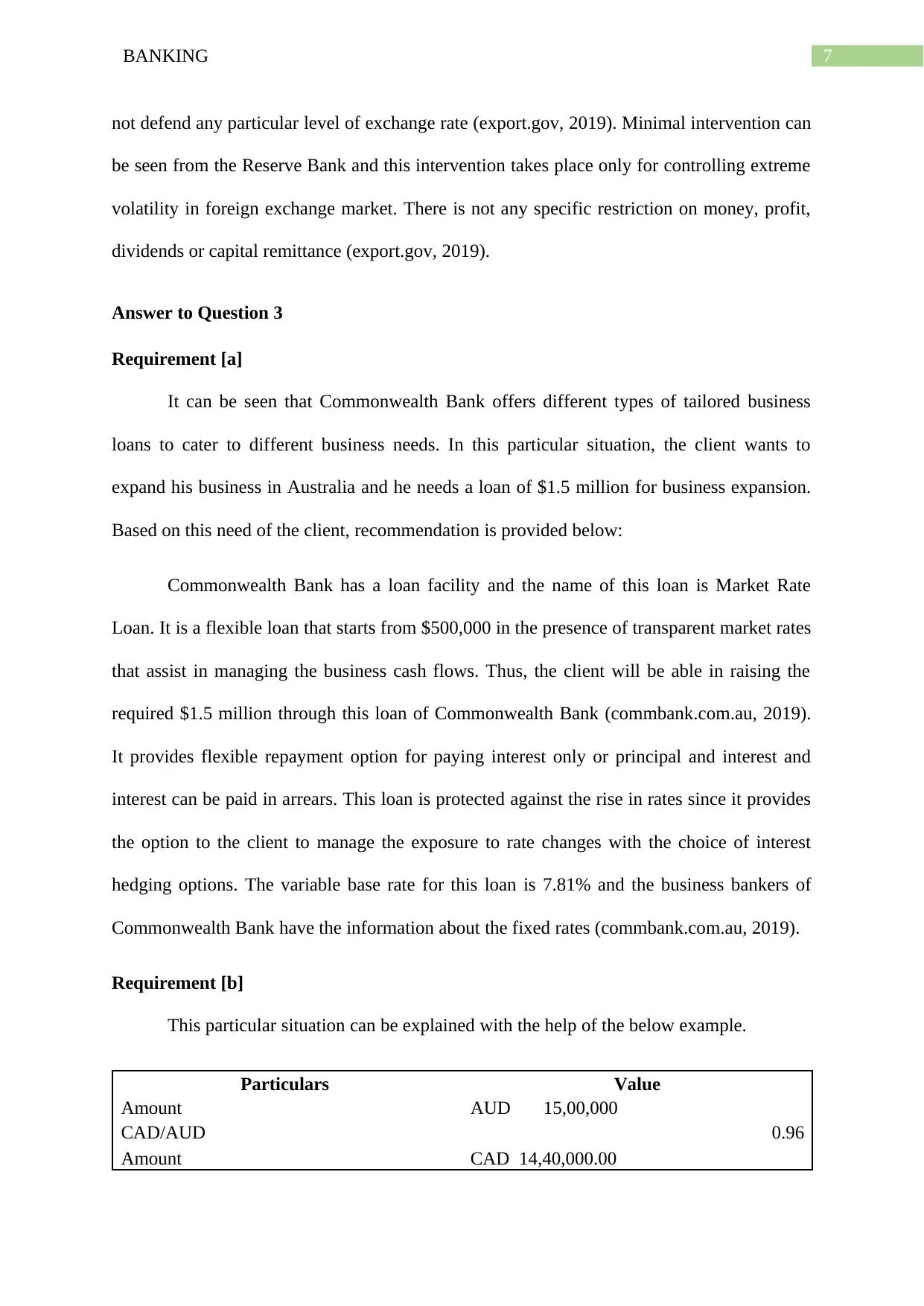
7BANKING
not defend any particular level of exchange rate (export.gov, 2019). Minimal intervention can
be seen from the Reserve Bank and this intervention takes place only for controlling extreme
volatility in foreign exchange market. There is not any specific restriction on money, profit,
dividends or capital remittance (export.gov, 2019).
Answer to Question 3
Requirement [a]
It can be seen that Commonwealth Bank offers different types of tailored business
loans to cater to different business needs. In this particular situation, the client wants to
expand his business in Australia and he needs a loan of $1.5 million for business expansion.
Based on this need of the client, recommendation is provided below:
Commonwealth Bank has a loan facility and the name of this loan is Market Rate
Loan. It is a flexible loan that starts from $500,000 in the presence of transparent market rates
that assist in managing the business cash flows. Thus, the client will be able in raising the
required $1.5 million through this loan of Commonwealth Bank (commbank.com.au, 2019).
It provides flexible repayment option for paying interest only or principal and interest and
interest can be paid in arrears. This loan is protected against the rise in rates since it provides
the option to the client to manage the exposure to rate changes with the choice of interest
hedging options. The variable base rate for this loan is 7.81% and the business bankers of
Commonwealth Bank have the information about the fixed rates (commbank.com.au, 2019).
Requirement [b]
This particular situation can be explained with the help of the below example.
Particulars Value
Amount AUD 15,00,000
CAD/AUD 0.96
Amount CAD 14,40,000.00
not defend any particular level of exchange rate (export.gov, 2019). Minimal intervention can
be seen from the Reserve Bank and this intervention takes place only for controlling extreme
volatility in foreign exchange market. There is not any specific restriction on money, profit,
dividends or capital remittance (export.gov, 2019).
Answer to Question 3
Requirement [a]
It can be seen that Commonwealth Bank offers different types of tailored business
loans to cater to different business needs. In this particular situation, the client wants to
expand his business in Australia and he needs a loan of $1.5 million for business expansion.
Based on this need of the client, recommendation is provided below:
Commonwealth Bank has a loan facility and the name of this loan is Market Rate
Loan. It is a flexible loan that starts from $500,000 in the presence of transparent market rates
that assist in managing the business cash flows. Thus, the client will be able in raising the
required $1.5 million through this loan of Commonwealth Bank (commbank.com.au, 2019).
It provides flexible repayment option for paying interest only or principal and interest and
interest can be paid in arrears. This loan is protected against the rise in rates since it provides
the option to the client to manage the exposure to rate changes with the choice of interest
hedging options. The variable base rate for this loan is 7.81% and the business bankers of
Commonwealth Bank have the information about the fixed rates (commbank.com.au, 2019).
Requirement [b]
This particular situation can be explained with the help of the below example.
Particulars Value
Amount AUD 15,00,000
CAD/AUD 0.96
Amount CAD 14,40,000.00
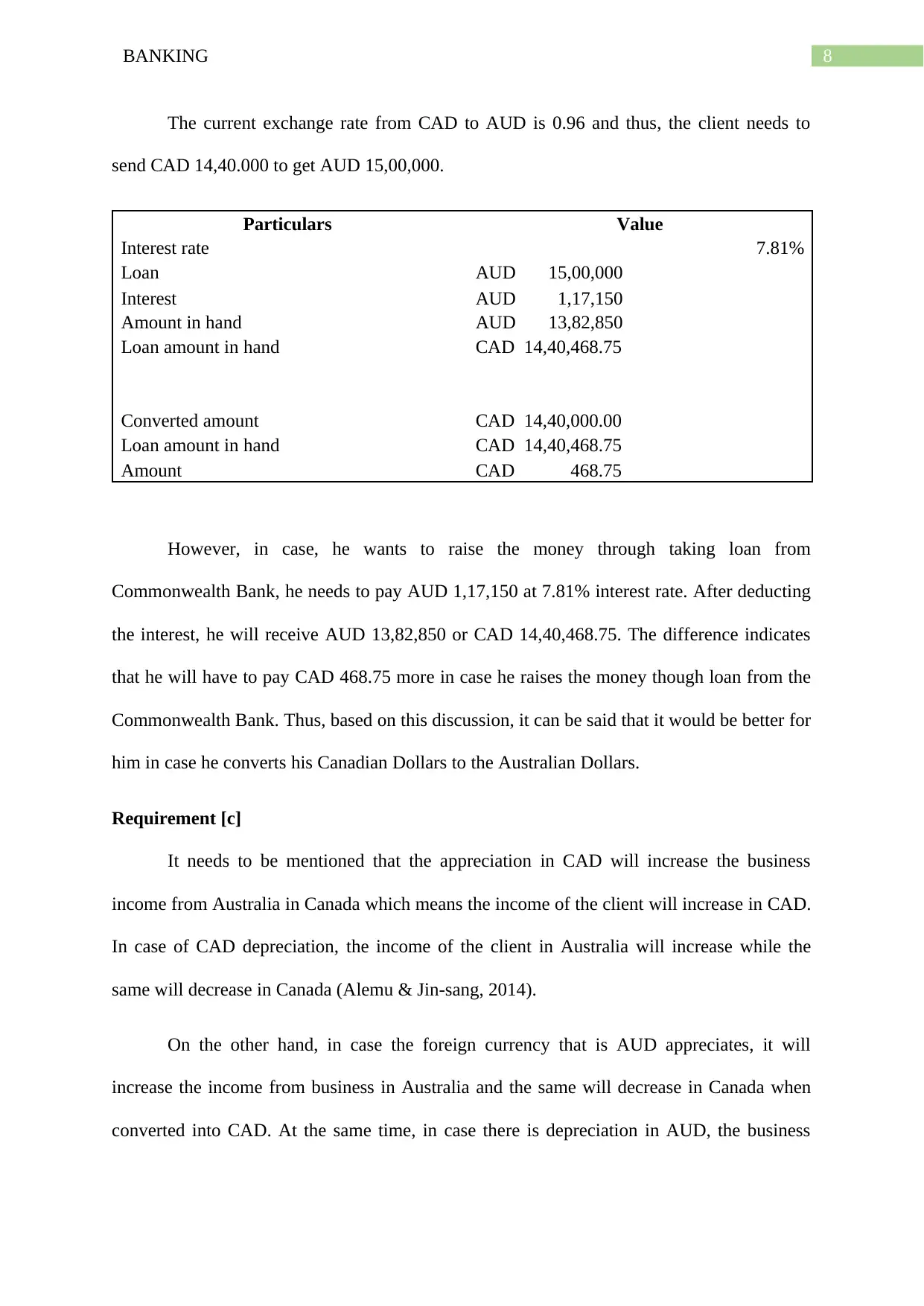
8BANKING
The current exchange rate from CAD to AUD is 0.96 and thus, the client needs to
send CAD 14,40.000 to get AUD 15,00,000.
Particulars Value
Interest rate 7.81%
Loan AUD 15,00,000
Interest AUD 1,17,150
Amount in hand AUD 13,82,850
Loan amount in hand CAD 14,40,468.75
Converted amount CAD 14,40,000.00
Loan amount in hand CAD 14,40,468.75
Amount CAD 468.75
However, in case, he wants to raise the money through taking loan from
Commonwealth Bank, he needs to pay AUD 1,17,150 at 7.81% interest rate. After deducting
the interest, he will receive AUD 13,82,850 or CAD 14,40,468.75. The difference indicates
that he will have to pay CAD 468.75 more in case he raises the money though loan from the
Commonwealth Bank. Thus, based on this discussion, it can be said that it would be better for
him in case he converts his Canadian Dollars to the Australian Dollars.
Requirement [c]
It needs to be mentioned that the appreciation in CAD will increase the business
income from Australia in Canada which means the income of the client will increase in CAD.
In case of CAD depreciation, the income of the client in Australia will increase while the
same will decrease in Canada (Alemu & Jin-sang, 2014).
On the other hand, in case the foreign currency that is AUD appreciates, it will
increase the income from business in Australia and the same will decrease in Canada when
converted into CAD. At the same time, in case there is depreciation in AUD, the business
The current exchange rate from CAD to AUD is 0.96 and thus, the client needs to
send CAD 14,40.000 to get AUD 15,00,000.
Particulars Value
Interest rate 7.81%
Loan AUD 15,00,000
Interest AUD 1,17,150
Amount in hand AUD 13,82,850
Loan amount in hand CAD 14,40,468.75
Converted amount CAD 14,40,000.00
Loan amount in hand CAD 14,40,468.75
Amount CAD 468.75
However, in case, he wants to raise the money through taking loan from
Commonwealth Bank, he needs to pay AUD 1,17,150 at 7.81% interest rate. After deducting
the interest, he will receive AUD 13,82,850 or CAD 14,40,468.75. The difference indicates
that he will have to pay CAD 468.75 more in case he raises the money though loan from the
Commonwealth Bank. Thus, based on this discussion, it can be said that it would be better for
him in case he converts his Canadian Dollars to the Australian Dollars.
Requirement [c]
It needs to be mentioned that the appreciation in CAD will increase the business
income from Australia in Canada which means the income of the client will increase in CAD.
In case of CAD depreciation, the income of the client in Australia will increase while the
same will decrease in Canada (Alemu & Jin-sang, 2014).
On the other hand, in case the foreign currency that is AUD appreciates, it will
increase the income from business in Australia and the same will decrease in Canada when
converted into CAD. At the same time, in case there is depreciation in AUD, the business
⊘ This is a preview!⊘
Do you want full access?
Subscribe today to unlock all pages.

Trusted by 1+ million students worldwide
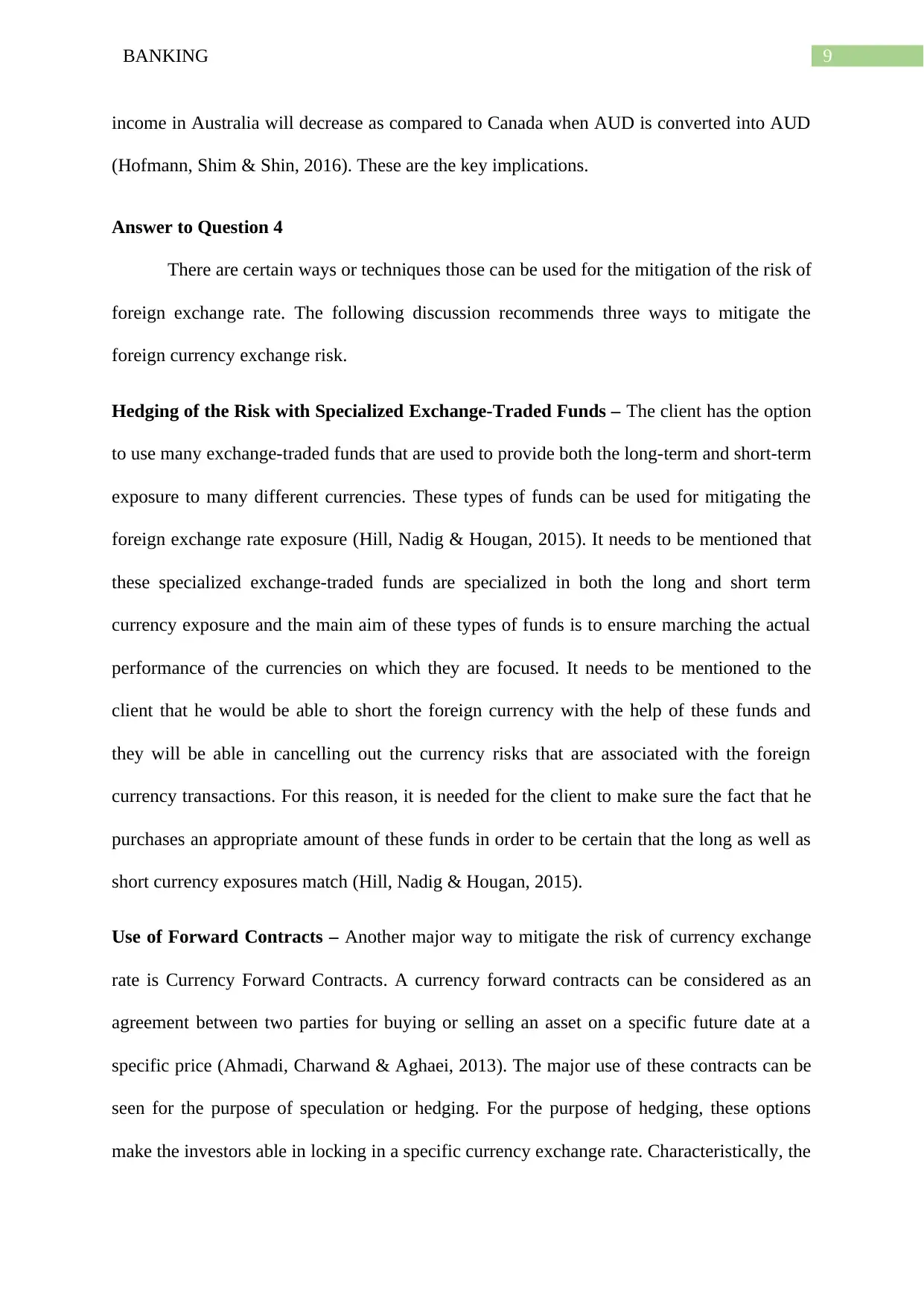
9BANKING
income in Australia will decrease as compared to Canada when AUD is converted into AUD
(Hofmann, Shim & Shin, 2016). These are the key implications.
Answer to Question 4
There are certain ways or techniques those can be used for the mitigation of the risk of
foreign exchange rate. The following discussion recommends three ways to mitigate the
foreign currency exchange risk.
Hedging of the Risk with Specialized Exchange-Traded Funds – The client has the option
to use many exchange-traded funds that are used to provide both the long-term and short-term
exposure to many different currencies. These types of funds can be used for mitigating the
foreign exchange rate exposure (Hill, Nadig & Hougan, 2015). It needs to be mentioned that
these specialized exchange-traded funds are specialized in both the long and short term
currency exposure and the main aim of these types of funds is to ensure marching the actual
performance of the currencies on which they are focused. It needs to be mentioned to the
client that he would be able to short the foreign currency with the help of these funds and
they will be able in cancelling out the currency risks that are associated with the foreign
currency transactions. For this reason, it is needed for the client to make sure the fact that he
purchases an appropriate amount of these funds in order to be certain that the long as well as
short currency exposures match (Hill, Nadig & Hougan, 2015).
Use of Forward Contracts – Another major way to mitigate the risk of currency exchange
rate is Currency Forward Contracts. A currency forward contracts can be considered as an
agreement between two parties for buying or selling an asset on a specific future date at a
specific price (Ahmadi, Charwand & Aghaei, 2013). The major use of these contracts can be
seen for the purpose of speculation or hedging. For the purpose of hedging, these options
make the investors able in locking in a specific currency exchange rate. Characteristically, the
income in Australia will decrease as compared to Canada when AUD is converted into AUD
(Hofmann, Shim & Shin, 2016). These are the key implications.
Answer to Question 4
There are certain ways or techniques those can be used for the mitigation of the risk of
foreign exchange rate. The following discussion recommends three ways to mitigate the
foreign currency exchange risk.
Hedging of the Risk with Specialized Exchange-Traded Funds – The client has the option
to use many exchange-traded funds that are used to provide both the long-term and short-term
exposure to many different currencies. These types of funds can be used for mitigating the
foreign exchange rate exposure (Hill, Nadig & Hougan, 2015). It needs to be mentioned that
these specialized exchange-traded funds are specialized in both the long and short term
currency exposure and the main aim of these types of funds is to ensure marching the actual
performance of the currencies on which they are focused. It needs to be mentioned to the
client that he would be able to short the foreign currency with the help of these funds and
they will be able in cancelling out the currency risks that are associated with the foreign
currency transactions. For this reason, it is needed for the client to make sure the fact that he
purchases an appropriate amount of these funds in order to be certain that the long as well as
short currency exposures match (Hill, Nadig & Hougan, 2015).
Use of Forward Contracts – Another major way to mitigate the risk of currency exchange
rate is Currency Forward Contracts. A currency forward contracts can be considered as an
agreement between two parties for buying or selling an asset on a specific future date at a
specific price (Ahmadi, Charwand & Aghaei, 2013). The major use of these contracts can be
seen for the purpose of speculation or hedging. For the purpose of hedging, these options
make the investors able in locking in a specific currency exchange rate. Characteristically, the
Paraphrase This Document
Need a fresh take? Get an instant paraphrase of this document with our AI Paraphraser
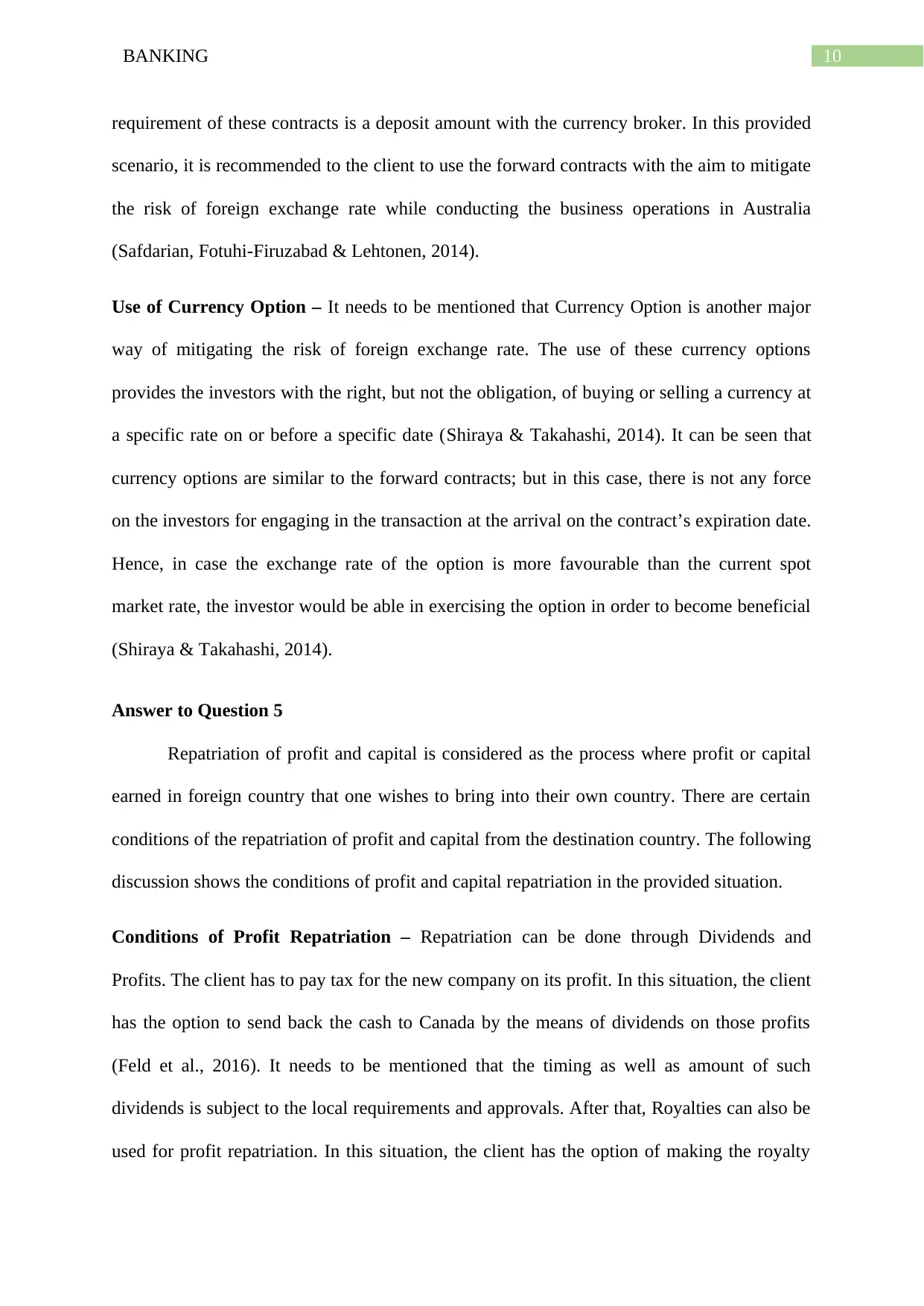
10BANKING
requirement of these contracts is a deposit amount with the currency broker. In this provided
scenario, it is recommended to the client to use the forward contracts with the aim to mitigate
the risk of foreign exchange rate while conducting the business operations in Australia
(Safdarian, Fotuhi-Firuzabad & Lehtonen, 2014).
Use of Currency Option – It needs to be mentioned that Currency Option is another major
way of mitigating the risk of foreign exchange rate. The use of these currency options
provides the investors with the right, but not the obligation, of buying or selling a currency at
a specific rate on or before a specific date (Shiraya & Takahashi, 2014). It can be seen that
currency options are similar to the forward contracts; but in this case, there is not any force
on the investors for engaging in the transaction at the arrival on the contract’s expiration date.
Hence, in case the exchange rate of the option is more favourable than the current spot
market rate, the investor would be able in exercising the option in order to become beneficial
(Shiraya & Takahashi, 2014).
Answer to Question 5
Repatriation of profit and capital is considered as the process where profit or capital
earned in foreign country that one wishes to bring into their own country. There are certain
conditions of the repatriation of profit and capital from the destination country. The following
discussion shows the conditions of profit and capital repatriation in the provided situation.
Conditions of Profit Repatriation – Repatriation can be done through Dividends and
Profits. The client has to pay tax for the new company on its profit. In this situation, the client
has the option to send back the cash to Canada by the means of dividends on those profits
(Feld et al., 2016). It needs to be mentioned that the timing as well as amount of such
dividends is subject to the local requirements and approvals. After that, Royalties can also be
used for profit repatriation. In this situation, the client has the option of making the royalty
requirement of these contracts is a deposit amount with the currency broker. In this provided
scenario, it is recommended to the client to use the forward contracts with the aim to mitigate
the risk of foreign exchange rate while conducting the business operations in Australia
(Safdarian, Fotuhi-Firuzabad & Lehtonen, 2014).
Use of Currency Option – It needs to be mentioned that Currency Option is another major
way of mitigating the risk of foreign exchange rate. The use of these currency options
provides the investors with the right, but not the obligation, of buying or selling a currency at
a specific rate on or before a specific date (Shiraya & Takahashi, 2014). It can be seen that
currency options are similar to the forward contracts; but in this case, there is not any force
on the investors for engaging in the transaction at the arrival on the contract’s expiration date.
Hence, in case the exchange rate of the option is more favourable than the current spot
market rate, the investor would be able in exercising the option in order to become beneficial
(Shiraya & Takahashi, 2014).
Answer to Question 5
Repatriation of profit and capital is considered as the process where profit or capital
earned in foreign country that one wishes to bring into their own country. There are certain
conditions of the repatriation of profit and capital from the destination country. The following
discussion shows the conditions of profit and capital repatriation in the provided situation.
Conditions of Profit Repatriation – Repatriation can be done through Dividends and
Profits. The client has to pay tax for the new company on its profit. In this situation, the client
has the option to send back the cash to Canada by the means of dividends on those profits
(Feld et al., 2016). It needs to be mentioned that the timing as well as amount of such
dividends is subject to the local requirements and approvals. After that, Royalties can also be
used for profit repatriation. In this situation, the client has the option of making the royalty
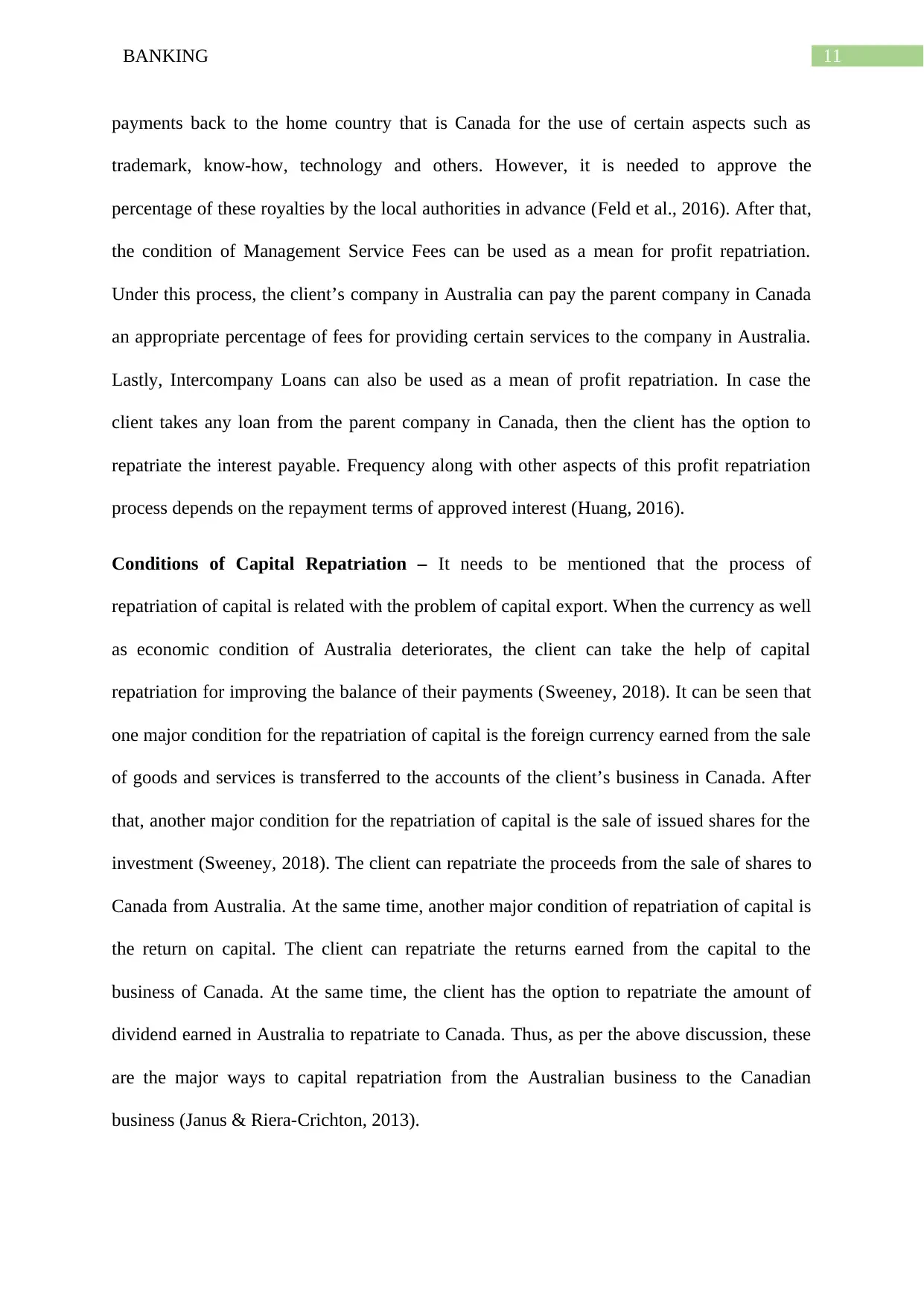
11BANKING
payments back to the home country that is Canada for the use of certain aspects such as
trademark, know-how, technology and others. However, it is needed to approve the
percentage of these royalties by the local authorities in advance (Feld et al., 2016). After that,
the condition of Management Service Fees can be used as a mean for profit repatriation.
Under this process, the client’s company in Australia can pay the parent company in Canada
an appropriate percentage of fees for providing certain services to the company in Australia.
Lastly, Intercompany Loans can also be used as a mean of profit repatriation. In case the
client takes any loan from the parent company in Canada, then the client has the option to
repatriate the interest payable. Frequency along with other aspects of this profit repatriation
process depends on the repayment terms of approved interest (Huang, 2016).
Conditions of Capital Repatriation – It needs to be mentioned that the process of
repatriation of capital is related with the problem of capital export. When the currency as well
as economic condition of Australia deteriorates, the client can take the help of capital
repatriation for improving the balance of their payments (Sweeney, 2018). It can be seen that
one major condition for the repatriation of capital is the foreign currency earned from the sale
of goods and services is transferred to the accounts of the client’s business in Canada. After
that, another major condition for the repatriation of capital is the sale of issued shares for the
investment (Sweeney, 2018). The client can repatriate the proceeds from the sale of shares to
Canada from Australia. At the same time, another major condition of repatriation of capital is
the return on capital. The client can repatriate the returns earned from the capital to the
business of Canada. At the same time, the client has the option to repatriate the amount of
dividend earned in Australia to repatriate to Canada. Thus, as per the above discussion, these
are the major ways to capital repatriation from the Australian business to the Canadian
business (Janus & Riera-Crichton, 2013).
payments back to the home country that is Canada for the use of certain aspects such as
trademark, know-how, technology and others. However, it is needed to approve the
percentage of these royalties by the local authorities in advance (Feld et al., 2016). After that,
the condition of Management Service Fees can be used as a mean for profit repatriation.
Under this process, the client’s company in Australia can pay the parent company in Canada
an appropriate percentage of fees for providing certain services to the company in Australia.
Lastly, Intercompany Loans can also be used as a mean of profit repatriation. In case the
client takes any loan from the parent company in Canada, then the client has the option to
repatriate the interest payable. Frequency along with other aspects of this profit repatriation
process depends on the repayment terms of approved interest (Huang, 2016).
Conditions of Capital Repatriation – It needs to be mentioned that the process of
repatriation of capital is related with the problem of capital export. When the currency as well
as economic condition of Australia deteriorates, the client can take the help of capital
repatriation for improving the balance of their payments (Sweeney, 2018). It can be seen that
one major condition for the repatriation of capital is the foreign currency earned from the sale
of goods and services is transferred to the accounts of the client’s business in Canada. After
that, another major condition for the repatriation of capital is the sale of issued shares for the
investment (Sweeney, 2018). The client can repatriate the proceeds from the sale of shares to
Canada from Australia. At the same time, another major condition of repatriation of capital is
the return on capital. The client can repatriate the returns earned from the capital to the
business of Canada. At the same time, the client has the option to repatriate the amount of
dividend earned in Australia to repatriate to Canada. Thus, as per the above discussion, these
are the major ways to capital repatriation from the Australian business to the Canadian
business (Janus & Riera-Crichton, 2013).
⊘ This is a preview!⊘
Do you want full access?
Subscribe today to unlock all pages.

Trusted by 1+ million students worldwide
1 out of 15
Related Documents
Your All-in-One AI-Powered Toolkit for Academic Success.
+13062052269
info@desklib.com
Available 24*7 on WhatsApp / Email
![[object Object]](/_next/static/media/star-bottom.7253800d.svg)
Unlock your academic potential
Copyright © 2020–2025 A2Z Services. All Rights Reserved. Developed and managed by ZUCOL.





